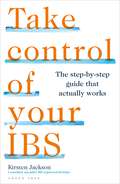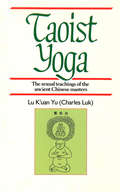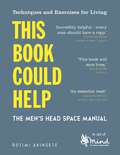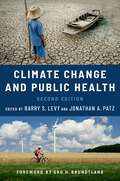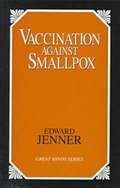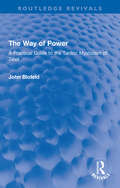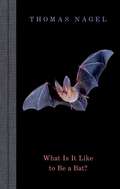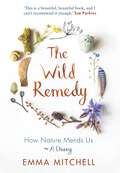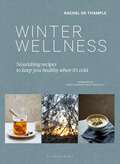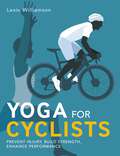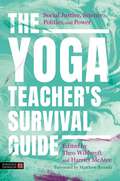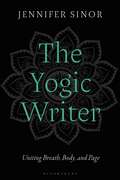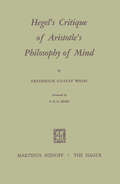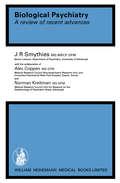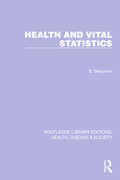- Table View
- List View
Supporting Anxiety and Vagus Nerve Dysfunction through Nutrition and Lifestyle
by Sasha HopeThe vagus nerve is responsible for the regulation of all our internal organ functions. When it is damaged, the wide-ranging impact on our nervous system can manifest in a multitude of ways, including anxiety, hormonal imbalances, gastrointestinal distress, and vertigo.Based on current research into the vagus nerve and vagus nerve stimulation, this practical guide addresses a crucial missing link in healthcare and functional medicine by providing an innovative protocol on the management of anxiety and vagus nerve dysfunction through nutrition, exercise, and lifestyle. With a holistic, whole-person approach, this protocol bridges the divide between the physical and the psychological, providing a holistic approach that can be applied widely across various disciplines within healthcare, bodywork, and mental health. It provides detailed theory and is supplemented with an abundance of practical guidance including various recipes whilst also helping practitioners understand how clients may transition to a more sustainable, long-term protocol.
Take Control of your IBS: The step-by-step guide that actually works
by Kirsten JacksonThe only book you need to understand and manage your IBS, written by consultant specialist IBS registered dietitian, Kirsten Jackson.Take Control of Your IBS is the road-tested, practical guide that will change your life. Offering simple, fad-free professional advice, it will help you diagnose issues, bring comfort and reduce symptoms and flare-ups.With so much misinformation out there for those of us with irritable bowel syndrome, it can be hard to know where to start. Drawing on scientific research and personal experience, consultant dietitian Kirsten Jackson guides you through each step.By laying strong foundations in your mental well-being, sleep optimisation, movement and nutrition as well as finding the right treatment, you can get back to the things you enjoy in life.· Find out how to get the right tests for your symptoms· Learn the tried-and-tested process that has been used in practice with thousands of IBS sufferers· Hear real-life experiences from people who have improved their livesThe good news is – it is possible to manage your IBS. This book shows you how.
Taoist Yoga: The Sexual Teachings of the Ancient Chinese Masters
by Lu Ku'An YuMany people today are familiar with Indian yoga but the secrets of the Chinese system have never been widely available. TAOIST YOGA offers a comprehensive course, which has passed down through the generations from ancient Chinese masters. Specially written to make its contents accessible to the Westerner, the book explains the mysteries of Taoist spiritual alchemy, which entails many sexual practices to preserve the generative force of the body.
This Book Could Help: The Men's Head Space Manual – Techniques and Exercises for Living
by MIND Rotimi Akinsete'Incredibly helpful - every man should have a copy' —Colin Jackson, former olympic athlete'This book will save lives.' —Elis & John, Radio X'An essential read' —Levison Wood, author and explorer___________________Your body needs maintaining to keep it healthy. So does your mind.Sounds simple, but tired and outdated ideas that tell men how they ought to be, mean the message gets lost. And the results speak for themselves: suicide is the biggest killer of men under fifty. There’s no more room for debate – taking care of your head space should be as normal as eating your five-a-day or going to the gym. Many books make impossible promises about how they will fix all your problems and stresses with some miraculous ten-step programme. This one doesn’t. What it does do is provide practical help, when times are tough and also when they’re not. And just like with your physical health, it doesn’t always have to take much to make a difference.Developed in partnership with Mind, the mental health charity, This Book Could Help is filled with straightforward expert advice and simple techniques to help you shake off what other people say you ought to be, prioritize yourself, meet challenges and develop new strengths, in areas such as dealing with stress, motivation, work and life goals. We all deserve to live fully and respect our struggles, so start here and back yourself every day.Because head space is not a luxury, it’s essential.
The Unknown God: W. T. Smith and the Thelemites (Oxford Studies in Western Esotericism)
by Martin P. StarrThe Unknown God is the first documentary study of Thelema, a twentieth-century religious movement in the "magical" family, founded by the occultist, poet, and prophet of a new age of personal freedom, Aleister Crowley (1875--1947). Martin P. Starr tells the history of the movement through the biography of its leader, Wilfred Talbot Smith (1885--1957), who took up Crowley's plans for organizations to teach the latter's methods in Western and Eastern esoteric traditions and his laws for a new world order, and established these systems in British Columbia and in California. Crowley provided the concepts; Smith and his associates made them take flesh, applying Crowley's doctrine of "Do what thou wilt" and cementing it a part of the artistic and religious underground of the twentieth century. This account provides a contextual overview of the elements of the resulting bricolage of religions, which included Freemasonry, Theosophy, Rosicrucianism, Neo-Gnosticism and other related forms of esotericism, demonstrating the overlap between apparently disparate ideologies, groups, and participants. Drawing primarily on diaries and letters, Starr gives a rare and fascinating study of the contemporaneous application of Crowley's thought, whose long trail we can see in the Satanism of Anton LaVey, the Scientology of L. Ron Hubbard, and the popularization of many forms of witchcraft, magic, and tantric practices.
Vaccination Against Smallpox
by Edward JennerIn the three treatises contained in this volume, originally published between 1798 and 1800, Jenner, who was a pioneer in demonstrating that vaccination was an effective means of preventing smallpox, summarizes his evidence in favor of vaccination and describes individual cases.
The Visions, Revelations and Teachings of Angela of Foligno: A Member of the Third Order of St Francis
Angela of Foligno was born in about 1248, twenty-two years after the death of Francis of Assisi, the saint on whom she was to model her life. With sudden deaths in her family, she felt called to follow a more religious and devout life, forsaking everything. In the years that followed she lived a life of total commitment to God. Her teachings and visions, and her deep spiritual wisdom, became internationally recognized as coming from a blessed person. This book provides the reader with a selection of Angela's visions and teachings drawn from The Divine Consolations of Angela of Foligno.
The Way of Power: A Practical Guide to the Tantric Mysticism of Tibet (Routledge Revivals)
by John BlofeldFirst published in 1970, The Way of Power is an exploration of the school of Mahayana Buddhism prevalent in Tibet and Mongolia, known as the Vajrayana. Divided into two parts, the book provides an introduction to the background and theory behind the Vajrayana before progressing to a study of Vajrayana in practice. In doing so, it provides an overview of the history, development, and contemporary status of the Vajrayana, and takes a look at the different schools and sects. The book’s primary focus is the use of Tantric mystical techniques. The Way of Power will appeal to those with an interest in Buddhism, religious psychology, and religious history.
The Way of Power: A Practical Guide to the Tantric Mysticism of Tibet (Routledge Revivals)
by John BlofeldFirst published in 1970, The Way of Power is an exploration of the school of Mahayana Buddhism prevalent in Tibet and Mongolia, known as the Vajrayana. Divided into two parts, the book provides an introduction to the background and theory behind the Vajrayana before progressing to a study of Vajrayana in practice. In doing so, it provides an overview of the history, development, and contemporary status of the Vajrayana, and takes a look at the different schools and sects. The book’s primary focus is the use of Tantric mystical techniques. The Way of Power will appeal to those with an interest in Buddhism, religious psychology, and religious history.
What Is It Like to Be a Bat?
by Thomas NagelA 50th anniversary edition of one of the most widely influential articles of 20th Century philosophy ?Consciousness is what makes the mind-body problem really intractable.? So begins Thomas Nagel's classic 1974 essay ?What is it Like to be a Bat?? Nagel's essay initiated the now widespread attention to consciousness as a central problem for philosophy, psychology, and neuroscience; it also influenced the recognition of the consciousness of nonhuman creatures as an important subject of study. Nagel argued that the essential subjectivity of conscious experience--what it is like for the creature undergoing it--means that reductionist theories of mind, which attempt to analyze it in physical terms, can never succeed. It follows that the physical sciences cannot provide a complete description of reality, and that the physical conception of objective reality must be transcended if science is going to comprehend the mind. This edition reissues this classic and widely influential article on its 50th anniversary, along with a new preface discussing the origins and influence of the essay, as well as ?Further Thoughts: The Psychophysical Nexus,? a supplementary essay which describes Nagel's later thoughts about how to respond to the problem posed by ?What Is It Like to Be a Bat?? This second essay suggests that the most promising path forward for the mind-body problem, if one accepts the irreducible subjectivity of consciousness, is to seek a necessary connection between mental and neurophysiogical states through a more fundamental type of state which is neither mental nor physical but necessitates them both as essential aspects. In other words, a state that is physical from the outside and mental from the inside, just as we are. This would be a form of monism, requiring the formation of new concepts, since our present concepts of the mental and the physical do not entail such a necessary connection. The essay explains why the relation between the mental and the physical may be necessary, even though our present concepts make it appear contingent.
Wicca: History, Belief & Community in Modern Pagan Witchcraft (The Sussex Library of Religious Beliefs & Practice)
by Ethan WhiteThe past century has born witness to a growing interest in the belief systems of ancient Europe, with an array of contemporary Pagan groups claiming to revive these old ways for the needs of the modern world. By far the largest and best known of these Paganisms has been Wicca, a new religious movement that can now count hundreds of thousands of adherents worldwide. Emerging from the occult milieu of mid twentieth-century Britain, Wicca was first presented as the survival of an ancient pre-Christian Witch-Cult, whose participants assembled in covens to venerate their Horned God and Mother Goddess, to celebrate seasonal festivities, and to cast spells by the light of the full moon. Spreading to North America, where it diversified under the impact of environmentalism, feminism, and the 1960s counter-culture, Wicca came to be presented as a Goddess-centred nature religion, in which form it was popularised by a number of best-selling authors and fictional television shows. Today, Wicca is a maturing religious movement replete with its own distinct world-view, unique culture, and internal divisions. This book represents the first published academic introduction to be exclusively devoted to this fascinating faith, exploring how this Witches' Craft developed, what its participants believe and practice, and what the Wiccan community actually looks like. In doing so it sweeps away widely-held misconceptions and offers a comprehensive overview of this religion in all of its varied forms. Drawing upon the work of historians, anthropologists, sociologists, and scholars of religious studies, as well as the writings of Wiccans themselves, it provides an original synthesis that will be invaluable for anyone seeking to learn about the blossoming religion of modern Pagan Witchcraft.
The Wild Remedy: How Nature Mends Us - A Diary
by Emma MitchellTHE SUNDAY TIMES BESTSELLER Emma Mitchell's richly illustrated and evocative diary records her nature finds over the course of a year and shows how being in the wild benefits our mental and physical wellbeing. 'This is a beautiful, beautiful book, I can't recommend it enough.' Sue Perkins_________________________‘Profound, inspiring and exquisite.’ Emma Freud_________________________‘Precise, gorgeous and inspiring.’ Amy Liptrot _________________________Emma Mitchell has suffered with depression – or as she calls it, 'the grey slug' – for twenty-five years. In 2003, she moved from the city to the edge of the Cambridgeshire Fens and began to take walks in the countryside around her new home, photographing, collecting and drawing as she went. In Emma's hand-illustrated diary, she takes us with her as she follows the local paths and trails, sharing her nature finds over the course of a year. Reflecting on how these encounters impact her mood, Emma's candid account of her own struggles is a powerful testament to how reconnecting with nature can be as medicinal as any talking therapy or pharmaceutical.Written with Emma's characteristic wit and frankness, and filled with her beautiful drawings, paintings and photography, this is a truly unique book for anyone who has ever felt drawn to nature and wondered about its influence over us.
Winter Wellness: Nourishing recipes to keep you healthy when it's cold
by Rachel de Thample'I love the winter months and I love Rachel de Thample's serious engagement with food as a way to living with connection and pleasure' Sheila Dillon--This book is a cordial invitation for you to embrace the essential transition of a winter wind-down.Winter Wellness empowers us with inspiring recipes and simple tips to support our immune system and mental health through the colder months, and makes it feel like a huge treat in doing so. Delving into the wisdom of using herbs and spices to boost our health, winter produce, easy ferments and nutritious homemade condiments that make meals a doddle, she offers recipes packed full of their delicious goodness.There are broths and soups, such as a dandelion and burdock ramen and parsnip toddy,easy-to-digest one-dish dinners like carrot miso mac,energising breakfasts such as banana bread blinis and tahini porridge, teas and tonics like homemade bitters and a night-time nutmeg nog, healthy treats like miso and pear mousse and orange and ginger date cake, and store-cupboard remedies including black garlic teriyaki and rhubarb pickled ginger.Winter Wellness brings warmth and joy to the coldest season, with delightful recipes and fresh insight to help inspire pause, reflection and nourishment at the time of year we need it most.
Yoga Animals: 32 Poses from the Wild
by Emily SharrattWritten by yoga instructor Emily Sharratt and featuring incredible artwork from artist Jade Mosinski, alongside step-by-step instructions for each pose, this is an essential manual and celebration of yoga. As every yoga practitioner knows, many of the key asanas (or poses) and breath exercises are inspired by the animal kingdom. From camels to cobras, and from lizards to lions, so many animals have loaned their characteristics and shape as well as their name to the practice of yoga. Whether you're channelling the flamboyance of a peacock or the pride and power of an eagle, you are part of an old and beautiful tradition, and one that is practised all over the world. The format of the book follows the template of a full, well-rounded yoga session, incorporating stretching, strengthening, energizing and calming elements, while drawing on a number of different yoga styles, from vinyasa flows to more static Yin poses.Yoga Animals is a beautiful collection of poses based in the natural world, which will show you how to embrace this within each yoga session.
Yoga for Cyclists: Prevent injury, build strength, enhance performance
by Lexie WilliamsonUnlock your cycling potential with yoga. Striving for stamina, power and speed can take its toll on the cyclist's body. Yoga is the ideal cycling companion to relieve the repetitive strains of riding, helping to ease tight muscles, increase mobility and reduce chances of injury. In this new edition of the bestselling title, learn how to use yoga to optimise your recovery, ride tension-free and enhance your performance. A specialist in yoga for cycling, Lexie Williamson guides you through tried-and-tested poses and mobility drills so you can: · gain a supple back, hips and hamstrings· adopt a stronger aerodynamic position through riding-specific core moves · develop efficient breathing and build a mind-body connection· recover more efficiently with restorative yoga practices Functional and accessible, Yoga for Cyclists adapts yoga techniques for modern cyclists of all levels, making it suitable for everyone from the beginner to the Tour de France-hopeful. By following step-by-step sequences, from quick hip releases to extended post-ride sessions, you'll discover how the power of yoga can transform your cycling. 'Handy for both beginners and pros... leaves no stone unturned.' – Women's Fitness 'A genuinely useful guide that will soon have tattered edges through use.' – Road.cc
The Yoga Teacher's Survival Guide: Social Justice, Science, Politics, and Power
by Theo Wildcroft Harriet McAteeThis is a yoga book with a difference. In this guide, the authors embark on a ground-breaking exploration of the multifaceted challenges faced by yoga teachers in today's complex world. Drawing upon their experience in training yoga teachers, Theo Wildcroft and Harriet McAtee have compiled a collection of wisdom from some of the best-known and respected yoga teachers worldwide, including Peter Blackaby, Donna Farhi, Jivana Heyman, and Jules Mitchell. Through this collaboration, these experts address six key themes that resonate deeply within the yoga teaching community: critical thinking, honouring our sources, scientific enquiries, trauma, race and equity, and money and power. This book will teach yoga teachers what they need to know about honouring yoga's sources and surviving and thriving in the modern yoga industry.
The Yogic Writer: Uniting Breath, Body, and Page
by Dr Jennifer SinorFusing the craft of writing with the philosophy of yoga, The Yogic Writer charts a path to the heart of creativity through the practice of yogic breathing, somatic exercises, and meditations. In response to an oftentimes paralyzing focus on outcome and product, Jennifer Sinor summons decades of experience teaching creative writing and yoga to guide our attention back to the body, the place from which all art arises.When invested with deep awareness, writing transforms us as human beings. The Yogic Writer connects the recursive process of writing – creating space for intentions, drafting, revision, and sitting in sites of possibility and potential – with the four stages of breath. Through brief insightful essays, Sinor meets writers in the present moment, providing craft advice while challenging us to explore how we look, who is really writing, and how to listen to our bodies. Steeped in ideas owed to ancient wisdom as well as creative writing pedagogy and Sinor's own experience, The Yogic Writer offers a unique, alternative approach to finding creativity that forsakes external validation for internal knowledge and experimentation. Inspirational, affirmational, and personal, this book is for anyone seeking permission to embody the life of a writer that they already know, deep down, to be theirs.
Current Topics in Clinical and Community Psychology: Volume 1
by Charles D. SpielbergerCurrent Topics in Clinical and Community Psychology, Volume 1 reviews advances in clinical and community psychology. Topics covered include theory and research in areas such as psychological assessment of intelligence, personality, and abnormal behavior; psychotherapy, broadly defined to include counseling and behavior modification; and psychophysiological and neurological determinants of personality and psychopathology.Comprised of five chapters, this volume first illustrates how reinforcement and modeling techniques can enable psychologists to function effectively as mental health consultants and agents of social change in an institution for delinquent children. The second chapter describes a unique program designed to prevent emotional dysfunction in school children by combining effective therapeutic intervention with relevant research and evaluation. The third chapter challenges the relevance of psychological research that does not take into account the relationship between the experimenter and his subjects, and instead demonstrates the impact of experimenter self-disclosure on the responses given to psychological tests and on subjects' behavior in psychology experiments. The fourth chapter proposes a behaviorally oriented model for the assessment of positive mental health and describes a successful application of this model in the assessment of the competence of college freshmen. The final chapter relates research on human psychophysiology to problems of psychological assessment and psychotherapy that are of central concern to clinical psychologists.This book should prove useful to practicing clinical and community psychologists, graduate and undergraduate students of psychology, and members of other mental health professions.
Fears and Phobias
by Isaac M. MarksFears and Phobias reviews and synthesizes the different viewpoints of learning theory, psychoanalysis, ethology, and clinical psychiatry with regards to fears and phobias. The causes and treatment of phobias are examined, with due regard for relevant biological and psychological issues. Topics covered range from the etiology of fear to clinical syndromes such as agoraphobic syndrome, animal phobias, social phobias, illness phobias, and obsessive phobias.Comprised of four chapters, this book begins with an overview of the historical aspects of phobias and the components of phobias, followed by a discussion on the etiology of fear. Experimental studies on fear that focus on innateness, maturation, and learning are examined, together with genetic aspects of timidity; the kinds of situations that are feared; and the physiology and learning of fear. The next chapter deals with clinical syndromes and the classification of phobic disorders such as the agoraphobic syndrome, specific animal phobias, and social phobias, along with illness phobias, obsessive phobias, autonomic equivalents to phobic disorders, and children's fears and phobias. The final chapter is devoted to prevention and treatment of phobias, including desensitization, and psychiatric management of phobic patients. This monograph will be of interest to psychiatrists and psychologists.
Hegel’s Critique of Aristotle’s Philosophy of Mind
by Frederick G. WeissAt opposite ends of over two millenia Hegel and Aristotle, virtually alone of the great European thinkers, consciously attempted to criticize and develop the thought of their predecessors into systems of their own. Both were thus committed in principle to the view that philosophy in each age of civilization is at once a product, a criticism, and a recon struction of the values and insights of its own past; that the fertile mind can only beget anew when it has acknowledged and understood a line of ancestors which has led to its begetting; that the thinker as little as the artist can start with a clean slate and a blankly open-minded atti tude to the world which he finds within him and before him. Man is by definition rational; philosophy is his continuous impulse to grasp and appraise a single universe of which he finds himself a part; philosophy therefore contains its history as a constituent element of its own nature, and the developmental character of philosophy must - unless human reason is, unthinkably and unarguably, a mere delusion - in some sense reflect, or even be in some sense identical with, an essentially develop mental universe - that is roughly the common creed of Aristotle and Hegel. Both of them further believed, as Plato had believed, that what is most real and intelligible in that universe is eo ipso most good.
Biological Psychiatry: A Review of Recent Advances
by J. R. SmythiesBiological Psychiatry: A Review of Recent Advances describes the developments in biological psychiatry. This book discusses the theories in the complex field of human disease, particularly psychiatric disease. Organized into six chapters, this book begins with an overview of the etiology and genetic basis of schizophrenia. This text then examines the various physiological and biochemical variables in schizophrenics. Other chapters consider the two types of depression, namely, reactive and endogenous. This book discusses as well the criteria of what symptom complexes constitute a particular psychiatric disease. The role of the brain in the control of learning, memory, behavior, and emotion is also reviewed. The final chapter deals with the psychoanalytic theory, which consists of a complex of theories of three various types. This book is a valuable resource for psychiatrists and physicians. Research workers in the various disciplines of neurobiology that encroach upon psychiatry will also find this book useful.
Health and Vital Statistics (Routledge Library Editions: Health, Disease and Society #3)
by Bernard BenjaminOriginally published in 1968, this book was intended to help those in health and welfare services as well as those whose policy decisions are influenced by the movement of statistical indices of health, to understand the purpose, derivation and meaning of these indices. It teaches by presenting statistical problems as they are encountered in practice against the background of day-to-day administrative procedures to which they relate. Special attention is paid to practices in the USA and to considerations of international comparability.
Health and Vital Statistics (Routledge Library Editions: Health, Disease and Society #3)
by Bernard BenjaminOriginally published in 1968, this book was intended to help those in health and welfare services as well as those whose policy decisions are influenced by the movement of statistical indices of health, to understand the purpose, derivation and meaning of these indices. It teaches by presenting statistical problems as they are encountered in practice against the background of day-to-day administrative procedures to which they relate. Special attention is paid to practices in the USA and to considerations of international comparability.


